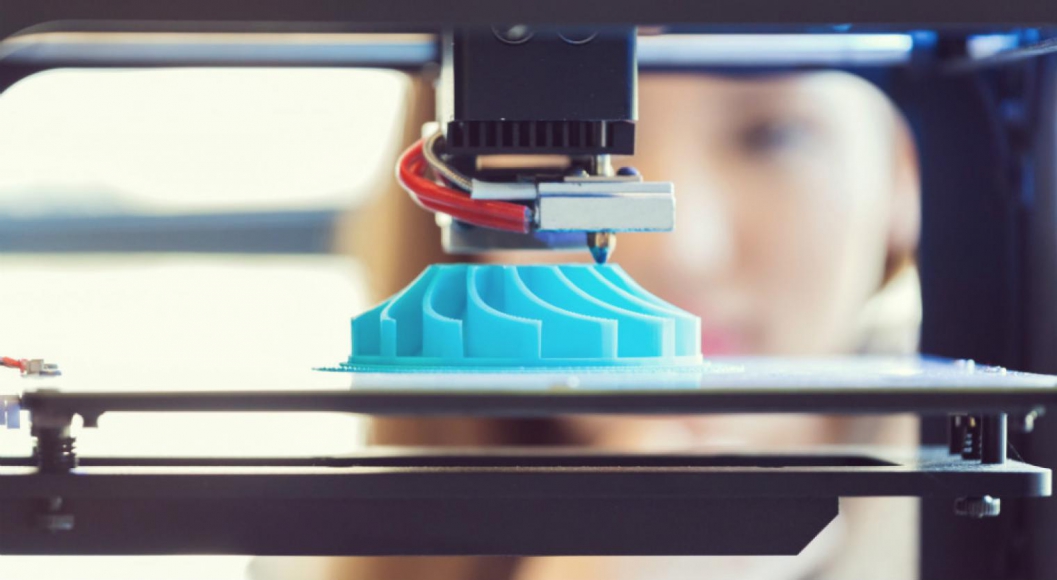3D printing, also known as additive manufacturing, is becoming a game-changer in many industries and supply chains--from the technology industry printing prototypes for new products (like computer mice) to manufacturing companies creating entire water filtration systems. They can be used to make quick scale models, fixtures, and jigs as well as final products -- from running shoes to jet engine fuel nozzles to electrical boxes in satellites.
These printers use a variety of technologies to create items in an additive, layered approach. The technologies vary from melting plastic filament and building a part using controlled print head movement, to a UV light reacting acrylic resin through precise layering or light focusing. Lasers can also be used to melt or sinter metal or nylon powders to make solid parts. 3D-made parts can then be finished like ‘ordinary’ parts through painting, polishing, buffing, plating, coating, sanding, cutting, and so on.
3D Printing Safety Issues and Guidelines: Hit Pause Before You Print
However, just like ‘ordinary’ manufacturing, additive processes also have hazards, emissions, and wastes. So before you get too caught up in the 3D printing excitement, make sure that your organization is fully considering the EHS implications of owning and operating a 3D printer. Understand the proper safeguards needed to ensure workplace safety every step of the way.
Here are our top eight environmental, health, and safety considerations to keep in mind when using 3D printing technology:
1. Energy Being Used to Transform Feedstock
Electricity, light, heat, and lasers are all forms of energy that can be used to transform your base feedstock into a printed part, and all of these have OSHA standards to comply with and the potential to cause injury. Make sure you understand and adequately plan for the type(s) of energy your setup will use and how you will meet applicable standards.
2. Base Material Hazards
Depending on the materials you will be using (resins, metals, plastics, etc), you will likely have EHS considerations to account for. You may be dealing with combustible powders or liquids, irritants, and sensitizers, or chronic inhalation hazards and will need to train and protect your employees accordingly.
3. Printer Location
While FDM and smaller stereolithography machines are often located in office areas or near regular 2D printers, laser sintering machines, post-processing, and larger machines typically are set up in separate spaces. With these dedicated spaces come specific ventilation and electrical safety needs to consider (in particular, use of combustible metals and powders can push your space into a different electrical code status), as well as possible plumbing and water needs. Also, be warned –employees and passers-by may want to see this new technology firsthand, so make sure the area is properly closed off and marked to avoid any incidents.
4. Applicable Regulations
3D printer emissions and employee exposures are regulated just like any other chemicals in the workplace. In particular, waste wash water is regulated in most areas (High Oxygen Demand BOD/COD and occasionally phenol may be present) and waste metal powders or fumes and waste solvents and alcohol rinses are also regulated wastes. Make sure to have a very clear understanding of your specific setup and your local regulations to remain compliant.
5. PPE Needs
From production of the print to washing off the support materials, PPE is necessary to ensuring health and safety. The usual safety glasses, goggles, rubber apron, rubber gloves (not nitrile or latex), long pants, long shirts, and work-appropriate shoes are needed. You may also need a spill kit, eyewash station, specific training, and signage, depending on the type of printer and the output.
6. Emissions, Exposure, and Risks During Printing
It is important to take into account the risks your employees will face during the printing process itself. For example, volatile organic compounds (VOCs) and ultrafine emissions are generated into the air by FDM and some jetting machines. Lasers and UV lights used in laser sintering and in stereolithography, on the other hand, require interlocks and other control measures in order to keep people safe.
7. Emissions, Exposure, and Risks After Printing
Every setup will be different, but there will likely be some exposure risk during your after-printing finishing processes. Examples include alcohol or solvent rinses to remove unreacted resins, alkaline solutions to remove support material in some FDM prints, painting/coating/plating finished colors and textures, sanding and buffing surfaces, cutting and grinding metal parts, or vapor degreaser smoothing. Make sure all of the relevant steps are accounted for in your planning and preparation.
8. Finished Product Design
While you will of course be concerned with the printer itself, don’t forget to also consider the environmental and sustainability impacts of its final output. Will it be recyclable? Can it be discarded with regular trash or is special disposal required? Is it biodegradable? Is it safe for children or irritating to skin? Now is the time to fully consider your process, component, and finish choices to have the most effect on your product’s final safety and sustainability specs.
Print is Not Dead, It’s Just Getting Started
Antea Group can help you set up a 3D printing operation, work through environmental waste and discharge questions, and evaluate the employee health and safety aspects of your machines. 3D printers can be operated safely and in a compliant manner; they just need planning, evaluation, and adjustments to ensure compliance and safety.
Contact us today if you have questions or are considering 3D printing and would like some additional EHS support.
Want more news and insights like this?
Sign up for our monthly e-newsletter, The New Leaf. Our goal is to keep you updated, educated and even a bit entertained as it relates to all things EHS and sustainability.
Get e-NewsletterHave any questions?
Contact us to discuss your environment, health, safety and sustainability needs today.




